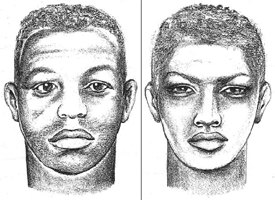Bridgeport 'Jane Doe' Killer Remains a Mystery
| By DAWN A. MICELI, Correspondent |
 “Jane Doe” was someone’s daughter,
and someone may have even referred to
her as “Mom.” Her ghastly demise 14
years ago seemingly eradicated every
trace of her identity. A “missing person”
search failed her as well. The last blow
may well be the ambiguity that surrounds
her cause of death, labeled in
police files as “pending.”
“Jane Doe” was someone’s daughter,
and someone may have even referred to
her as “Mom.” Her ghastly demise 14
years ago seemingly eradicated every
trace of her identity. A “missing person”
search failed her as well. The last blow
may well be the ambiguity that surrounds
her cause of death, labeled in
police files as “pending.”
“As far as I’m concerned, I say she was
murdered,” said Bridgeport Police Detective
Heitor Teixeira, an 18-year veteran
who is currently assigned to cold cases in
the department. “We figured she was a
drug carrier, and probably not even from
this area – I wish that we had more. It’d
be nice to have some closure.”
It is that closure aspect that is compelling
Teixeira to reinvestigate the meager
evidence initially recovered from the
site where Jane Doe’s charred body was
found. Even a recent setback in the case
– the body has now been buried by the
chief medical examiner’s office after having
lain in the state morgue for 10 years
– has done little to deter the detective
from exploring all avenues. Exhumation
of the body for updated forensic testing is
a possibility.
A 911 fire call came in to the Bridgeport
Fire Department at about 5:30 a.m.
on June 5, 1993. Two people smelled
smoke near where they worked and called
to report it. Emergency crews responded
to a vacant parking lot at Lafayette Street
and Railroad Avenue, an overgrown area
right near the highway that sported the
ripest kind of kindling: brush, tall grass,
and small trees. The fire had been burning
for a while.
Once the flames were under control,
firefighters came upon a gruesome discovery.
Amid the debris that littered the
area were the charred remains of a faceless
body, the hands and feet burned
away from the stumps that remained in
the regions where there once were arms
and legs.
In the police report, first responders
reported the overpowering smell of gasoline
emanating from the area. A book of
matches was found near the body, as well
as an antifreeze jug containing some
gasoline. The victim had been doused
with the fuel and set on fire.
Michael Kerwin, a former Bridgeport
police sergeant who had worked on the
case, recalled the intense heat that so
engulfed the body that investigators were
never able to learn whether the victim died
before the fire or during it. “They (her
killer or killers) had to flip her over a couple
of times for being that burned,” said
Kerwin, who now works for the state’s
attorney’s office in Fairfield. “She was
rolled over and doused again and again.”
Bridgeport police had to secure the
services of a forensic anthropologist just
to ascertain some of the basic genetic
makeup of the victim. According to Teixeira,
that person was Dr. Albert Harper,
the executive director of the Dr. Henry C.
Lee Institute of Forensic Science.
Harper determined that Jane Doe was
probably a black female, between the ages
of 25 and 35, with a slight build, between
five-foot-one and five-foot-four. A composite
facial reconstruction was never an
option for the department because of the
condition of the corpse.
An investigation by the fire marshal’s
office confirmed that “gas or acceleranttype
materials (were) used to cause the
fire.” At 5:30 in the morning, police say
there were not many gas stations open in
the area, save for the one on Park Avenue
and State Street. There, a station attendant
recalled two men who had come in
with a beer bottle, requesting that it be
filled with gasoline. The attendant
refused; but 15 to 20 minutes later, the
men were back with an antifreeze jug and
purchased one dollar’s worth of gas.
They chucked the beer bottle into the
station’s trash can.
The attendant was able to provide
police with details on the two men: one
was a black male of average height and
build in his late teens to early 20s. His
companion was said to be a Hispanic male
of similar height, build, and age. A
department sketch artist came up with two
composite drawings of the suspects, but
the investigation failed to locate the men,
let alone bring up charges on anyone.
No one ever came looking for Jane
Doe, and a nationwide “missing person”
search failed to garner a match. “We had
dozens and dozens of ‘hits’ come back
from across the country, but nothing ever
matched,” said Kerwin. “There was
always something wrong – like the eye
color or something.”
However, a case currently in the news
triggered Kerwin’s memory of the young
woman who was never identified.
Emanuel Lovell Webb is charged with
killing four women in Bridgeport during
the same timeframe as Jane Doe’s death.
Webb was extradited from Georgia by
authorities in Connecticut, and Kerwin
figured he should be questioned about
the burn victim as well – just in case.
“When they brought him back here, I
told Teixeira to ask him about this girl,”
Kerwin said. “If he’s going to start
spilling his guts, they may as well ask
about her.”
That idea did not pan out, but it did
compel Teixeira to reexamine whatever
evidence there was in the 14-year-old
case. He saw that as of 1998, the body
was still at the chief medical examiner’s
office in Farmington. A subsequent call
to the office revealed that in 2003, the
body was buried in Bloomfield at the
expense of a local funeral home. According
to a spokeswoman for the chief medical
examiner, the State of Connecticut
does not have a “pauper’s grave.” In addition,
“We do not cremate someone who
is unidentified,” said the spokeswoman,
who declined to give her name. “She was
kept here 10 years.” The spokeswoman
added that a court order would allow for
the body to be disinterred.
Even with the body, said Elaine
Pagliaro, the assistant director of the
state’s forensic laboratory in Meriden,
someone from Jane Doe’s past would
have had to have reported her missing.
“If there are no relatives who submitted
samples, we could put it in (the database)
and never get a hit,” Pagliaro said.
“To identify an unknown individual,
there needs to be some record of that
person.”
Even without a body, there is other
evidence that can be examined, Teixeira
said. There were fingerprints on the
beer bottle and on the matchbook recovered
at the scene. “That’s probably the
most compelling thing we have,” said
Teixeira. Several teeth were also preserved,
“and that’s another avenue we
can look into,” he said. The detective
also plans to contact Harper, the original
forensic anthropologist, to enlist his aid
in the reexamination of evidence.
Kerwin agrees the passing of time
may have been enough to create a new
opening in the case. “Forensics has
come a long way since then, and there
are samples on file,” he said. “That one
was always – ‘Who was that girl?’ It was
just a lonely south-end lot.”
Jane Doe, buried in a nameless plot in
Bloomfield, without so much as a date of
birth or next of kin to define her lineage
or indeed her existence, died 14 years
ago. Her case is still very much “open,”
and anyone with any possible clues is
asked to contact the Bridgeport police.
(Contact Dawn at d.miceli@thejusticejournal.com)
|






